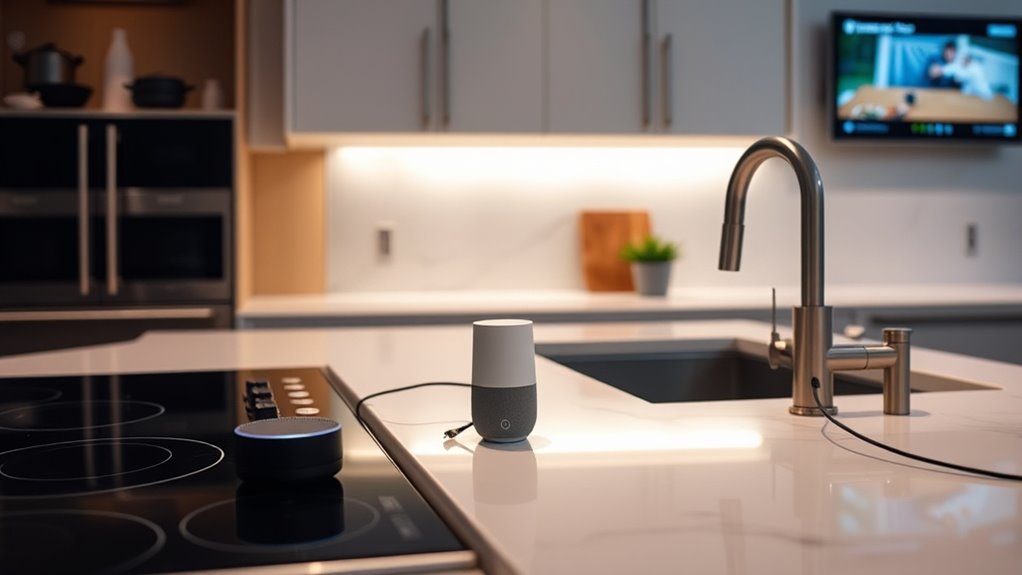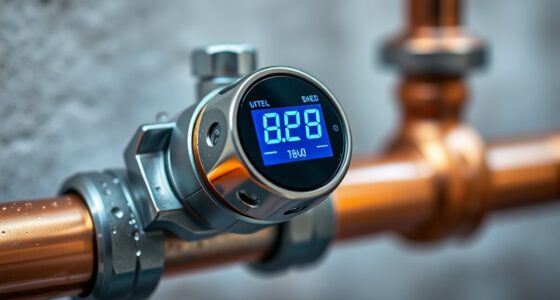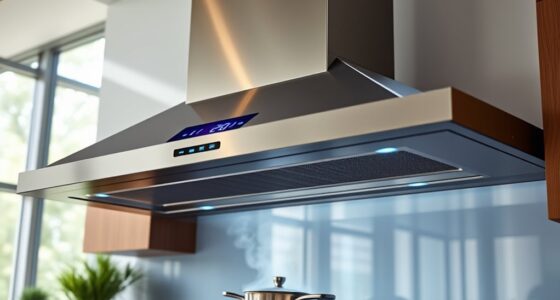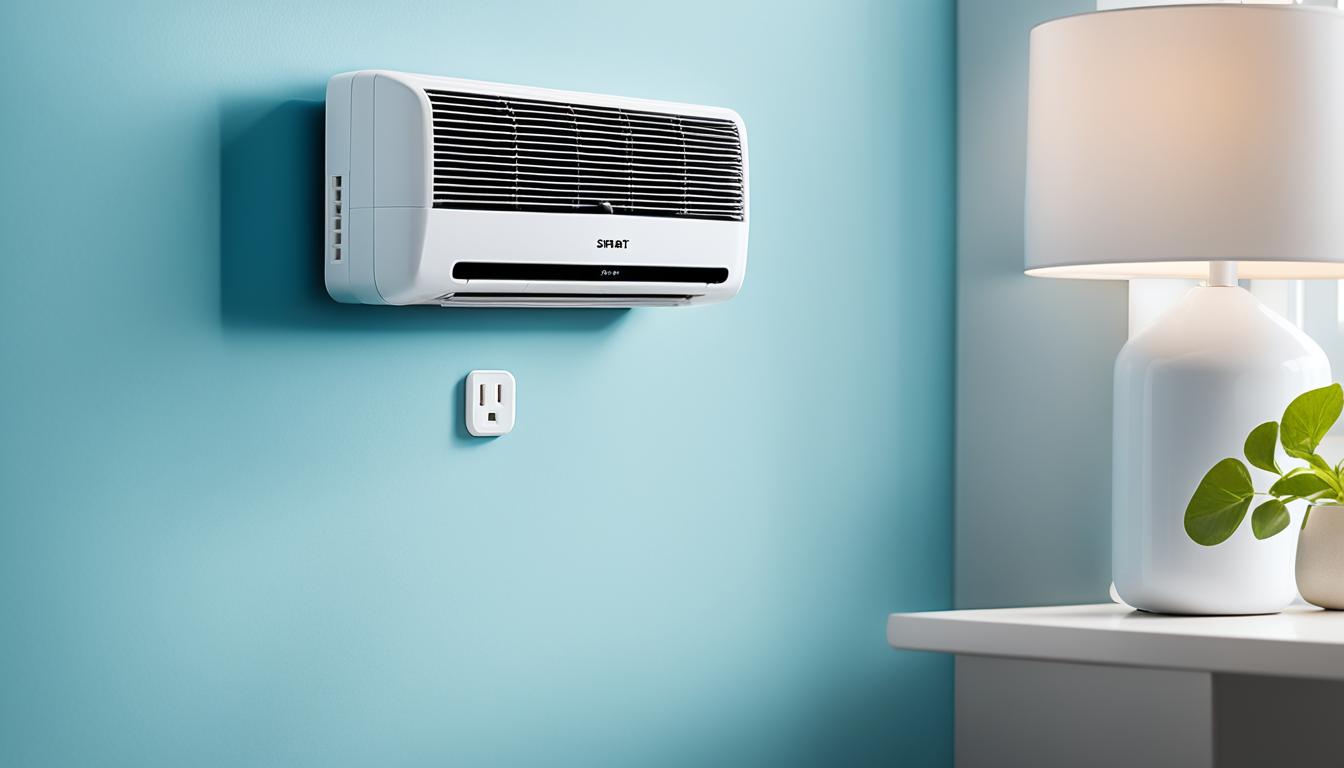To set up a voice-controlled kitchen, start by choosing compatible smart devices like speakers, appliances, and lights that work well together, ideally connecting them through a central hub or Wi-Fi. Position your devices thoughtfully for clear voice commands and organize them into groups for easier control. Create routines to automate tasks like turning on the coffee or adjusting lighting. Keep privacy and security in mind by updating firmware and managing settings—continue to explore how to make your smart kitchen more efficient.
Key Takeaways
- Choose compatible smart devices and connect them via a central hub or Wi-Fi for seamless integration.
- Position speakers strategically to ensure clear voice recognition and avoid miscommunication.
- Create routines to automate multiple tasks with single commands, enhancing convenience and efficiency.
- Regularly update device firmware and review privacy settings to maintain security and protect data.
- Organize devices into groups for easier control and optimize placement for natural voice command recognition.

Imagine a kitchen where you can control appliances, adjust recipes, and access information simply by speaking. With voice assistants, this becomes your everyday reality. Setting up a voice-controlled kitchen starts with selecting compatible devices that support smart home integration. You’ll want smart speakers, voice assistants, and appliances that work seamlessly together. Once you’ve chosen your devices, connect them through a central hub or directly via your Wi-Fi network. This ensures you can issue commands effortlessly—whether it’s turning on the oven, adjusting the lighting, or fetching a recipe online.
However, as you integrate more devices, user privacy considerations come into play. Voice assistants are always listening for activation words, which raises questions about data security. To safeguard your privacy, review your device settings and disable any features that record or store conversations you don’t want saved. Many smart home devices offer privacy controls, allowing you to delete voice recordings or limit what data is shared. It’s essential to stay informed about each device’s privacy policy and regularly update your firmware to patch security vulnerabilities. Being proactive about privacy guarantees your smart kitchen remains a secure space, giving you confidence in using voice commands without risking unwanted data exposure.
In setting up your voice-controlled kitchen, consider the placement of your devices. Speakers should be positioned where they can clearly pick up your voice, yet not so close that they pick up every word in the room. Proper placement minimizes miscommunication and ensures your commands are accurately executed. You’ll also want to organize your smart devices into groups—like lighting, cooking appliances, and entertainment—so that you can control multiple devices with a single command. Many voice assistants allow you to customize routines, enabling you to automate sequences like turning off lights, locking doors, and starting the coffee maker with a single phrase.
As you become more familiar with your setup, explore voice commands specific to your devices and routines. Many assistants support natural language, so you don’t have to memorize precise commands. For example, you might say, “Hey Assistant, start dinner prep,” and your system can turn on the oven, set a timer, and play your favorite cooking playlist. Remember, the more integrated your smart home is, the smoother your experience becomes. But always keep privacy in mind—regularly check your device settings and stay updated to keep your voice-controlled kitchen both efficient and secure. Understanding projectors’ contrast ratio With a little effort, your new kitchen setup becomes an intuitive, hands-free space that simplifies your cooking and daily routines.
Frequently Asked Questions
How Secure Are Voice-Controlled Kitchen Devices From Hacking?
Voice-controlled kitchen devices are fairly secure if you implement proper measures. They use voice encryption to protect your commands from eavesdroppers, and device authentication ensures only authorized devices access your system. However, no technology is completely foolproof. You should regularly update firmware, use strong Wi-Fi passwords, and enable two-factor authentication when available. Staying vigilant helps minimize hacking risks and keeps your kitchen smart and safe.
Can Multiple Users Personalize Voice Commands Effectively?
You can absolutely personalize voice commands with multiple user profiles! Imagine having a kitchen where each person’s preferences are instantly recognized, making command customization effortless. Your voice assistant adapts seamlessly, creating tailored experiences for everyone. By setting up individual user profiles, you guarantee commands are accurate and personalized. It’s like having your own kitchen concierge, always ready to respond perfectly to each user’s unique voice and needs.
What Are the Privacy Implications of Using Voice Assistants in the Kitchen?
Using voice assistants in your kitchen raises privacy concerns because they involve data collection about your voice commands and habits. You should be aware that your devices collect and store data, which could be accessed or misused if not properly protected. Always review user consent policies, and configure privacy settings to limit data sharing, ensuring you maintain control over your personal information while enjoying the convenience of voice-controlled appliances.
How Do I Troubleshoot Voice Recognition Issues During Cooking?
If you’re having voice recognition issues during cooking, start by redoing the voice training to improve accuracy. Make sure to clear the microphone area from food or steam, and enable noise suppression features to reduce background sounds. Speak clearly and at a steady pace, directly towards the assistant. Adjust your device’s sensitivity settings if needed, and guarantee your assistant software is up to date for peak performance.
Are There Compatibility Concerns With Different Smart Home Brands?
You might face brand compatibility issues when integrating different smart home devices in your kitchen. Not all brands work seamlessly together, so check if your preferred assistant supports device integration across brands. To avoid problems, choose devices that specify compatibility with your voice assistant. This ensures smooth operation and efficient control, making your voice-controlled kitchen more functional without frustrating glitches or limited device interactions.
Conclusion
As you set up your voice-controlled kitchen, think of it as planting a seed that grows into a seamless, smart space. With your assistant guiding every step, you’ll transform your kitchen into a symphony of convenience and innovation. Embrace the journey, and soon your voice commands will flow effortlessly, turning your culinary space into a well-orchestrated masterpiece where technology and daily life dance in harmony.









